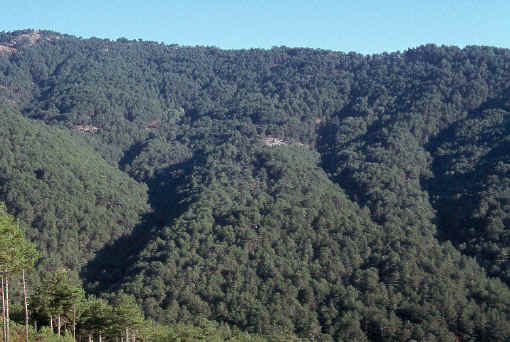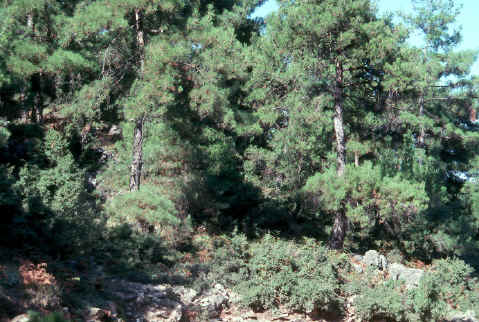______________________________________________________________________
LOWLAND
CONIFERS
 The
'emerald isle' of Thásos is extensively forested and in the early 1980s (prior
to the recent series of devastating summer fires) conifers were reported as
covering 44% of the land surface. The forests are owned by
the municipal authorities and the Greek Forest Service, with timber production
amounting to some 25,000 cubic metres per year (although this has presumably
declined in recent years). The summer fires of 1985 & 1989 were a disaster
for the forestry industry as well as wildlife and in response conspicuous
firebreaks were bulldozed throughout the forests in an attempt to control future
outbreaks.
The
'emerald isle' of Thásos is extensively forested and in the early 1980s (prior
to the recent series of devastating summer fires) conifers were reported as
covering 44% of the land surface. The forests are owned by
the municipal authorities and the Greek Forest Service, with timber production
amounting to some 25,000 cubic metres per year (although this has presumably
declined in recent years). The summer fires of 1985 & 1989 were a disaster
for the forestry industry as well as wildlife and in response conspicuous
firebreaks were bulldozed throughout the forests in an attempt to control future
outbreaks.
Large areas of
the western half of the island, from Rachoni to Potos, are now substantially devoid of
woodland. 17,400 hectares of forest were destroyed in the two major fires
and it is now estimated that only 2024 ha of mature pine forest survives
in the lowlands. However, regeneration is rapid and several studies (Gitas et
al 2000, Spanos 1994, Spanos & Spanos 1996, Spanos et al 2000, Spanos et
al 2001) have shown the rapid establishment of typical scrub species and
high germination rates for conifer seedlings. "Most burned sites on Thásos
have been restored by post-fire natural regeneration, with a rich vegetation
cover and high species abundance" (Spanos et al 2001) and, given
protection from further fires, conifer forests will once again cover much of the
lowland landscape of Thásos.
 In
the lowlands, extending up to c. 450 metres a.s.l., Calabrian pine Pinus
halepensis spp. brutia forms the forest cover. This subspecies
(sometimes considered to be a separate species Pinus brutia) is
restricted to Turkey, Crete and eastern Greece, but it closely resembles the
nominate form, Aleppo pine Pinus h. halepensis, with a similar growth
form and understorey communities. Characteristically, the shrub layer consists
of Cistus phrygana (see: Scrub) in which pink cistus Cistus
creticus and tree heath Erica manipuliflora are
abundant. This type of forest is widely distributed on Thásos and can be
readily seen in the north of the island, for instance, along the roadside
between Cape Pachys and Skala Rachoni. A walk through the forest around the Temple of
Athena, between Thassos Town and Makriammos, gives a good introduction to this
type of habitat. Taller shrub layers, known as maquis (see: Scrub),
represent successional development from the woodland phrygana, but grazing
pressure (Makedos 1987), fire and timber production often prevent maquis from establishing. Examples
of the latter are found throughout the forested areas on the island and the species component
varies according to soil moisture and geology.
In
the lowlands, extending up to c. 450 metres a.s.l., Calabrian pine Pinus
halepensis spp. brutia forms the forest cover. This subspecies
(sometimes considered to be a separate species Pinus brutia) is
restricted to Turkey, Crete and eastern Greece, but it closely resembles the
nominate form, Aleppo pine Pinus h. halepensis, with a similar growth
form and understorey communities. Characteristically, the shrub layer consists
of Cistus phrygana (see: Scrub) in which pink cistus Cistus
creticus and tree heath Erica manipuliflora are
abundant. This type of forest is widely distributed on Thásos and can be
readily seen in the north of the island, for instance, along the roadside
between Cape Pachys and Skala Rachoni. A walk through the forest around the Temple of
Athena, between Thassos Town and Makriammos, gives a good introduction to this
type of habitat. Taller shrub layers, known as maquis (see: Scrub),
represent successional development from the woodland phrygana, but grazing
pressure (Makedos 1987), fire and timber production often prevent maquis from establishing. Examples
of the latter are found throughout the forested areas on the island and the species component
varies according to soil moisture and geology.
REFERENCES
Gitas, I.,
Radoglou, K., Devereux, B. & Spanos, I. 2000. Comparative study of
post-fire ecosystem recovery by using field plots and geographical information
sysytems. Ed. V. Tsihrintzis. Proceedings of the International Conference
on the Protection and Restoration of the Environment, V: pp: 651-658.
University of Thrace.
Makedos, I. 1987. The
Pinus brutia forests of Thasos. Ed. V. Papanastasis. Proceedings of the
Conference on Pinus halepensis and Pinus brutia forests - ecology,
management and development, . pp: 153-160. Hellenic
Association of Foresters. [in Greek]
Spanos, I. 1994.
Natural regeneration of Pinus brutia on the burnt areas in the
northwestern areas of the island of Thasos. Geotech. Sci., 4:
33-39. [in Greek]
Spanos, I.A.,
Daskalakou, E.N. & Thanos, C.A. 2000. Postfire, natural regeneration of Pinus
brutia forests in Thasos Island, Greece. Acta Oecologica, 21:
13-20.
Spanos, I. &
Spanos, K. 1996. Postfire establishment and survival of Pinus brutia on the
island of Thasos. pp: 163-168. Proceedings of the Second Balkan
Scientific Conference, June 3-5, 1996, 1996. Sofia.
Spanos, I.A.,
Radoglou, K.M. & Raftoyannis, Y. 2001. Site quality effects on post-fire
regeneration of Pinus brutia forest on a Greek island. Applied
Vegetation Science, 4: 229-236.






 The
'emerald isle' of Thásos is extensively forested and in the early 1980s (prior
to the recent series of devastating summer fires) conifers were reported as
covering 44% of the land surface. The forests are owned by
the municipal authorities and the Greek Forest Service, with timber production
amounting to some 25,000 cubic metres per year (although this has presumably
declined in recent years). The summer fires of 1985 & 1989 were a disaster
for the forestry industry as well as wildlife and in response conspicuous
firebreaks were bulldozed throughout the forests in an attempt to control future
outbreaks.
The
'emerald isle' of Thásos is extensively forested and in the early 1980s (prior
to the recent series of devastating summer fires) conifers were reported as
covering 44% of the land surface. The forests are owned by
the municipal authorities and the Greek Forest Service, with timber production
amounting to some 25,000 cubic metres per year (although this has presumably
declined in recent years). The summer fires of 1985 & 1989 were a disaster
for the forestry industry as well as wildlife and in response conspicuous
firebreaks were bulldozed throughout the forests in an attempt to control future
outbreaks.  In
the lowlands, extending up to c. 450 metres a.s.l., Calabrian pine Pinus
halepensis spp. brutia forms the forest cover. This subspecies
(sometimes considered to be a separate species Pinus brutia) is
restricted to Turkey, Crete and eastern Greece, but it closely resembles the
nominate form, Aleppo pine Pinus h. halepensis, with a similar growth
form and understorey communities. Characteristically, the shrub layer consists
of Cistus phrygana (see:
In
the lowlands, extending up to c. 450 metres a.s.l., Calabrian pine Pinus
halepensis spp. brutia forms the forest cover. This subspecies
(sometimes considered to be a separate species Pinus brutia) is
restricted to Turkey, Crete and eastern Greece, but it closely resembles the
nominate form, Aleppo pine Pinus h. halepensis, with a similar growth
form and understorey communities. Characteristically, the shrub layer consists
of Cistus phrygana (see: